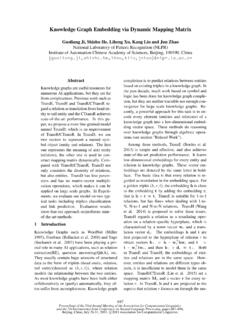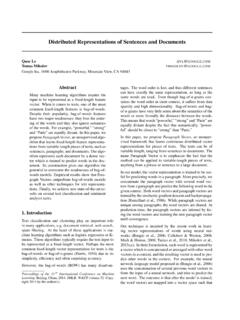Transcription of Implicit Neural Representations with Periodic Activation …
1 Implicit Neural Representations with Periodic Activation Functions Vincent Sitzmann Julien N. P. Martel Alexander W. Bergman [ ] 17 Jun 2020. David B. Lindell Gordon Wetzstein Stanford University Abstract Implicitly defined, continuous, differentiable signal Representations parameterized by Neural networks have emerged as a powerful paradigm, offering many possible benefits over conventional Representations . However, current network architectures for such Implicit Neural Representations are incapable of modeling signals with fine detail, and fail to represent a signal's spatial and temporal derivatives, despite the fact that these are essential to many physical signals defined implicitly as the solution to partial differential equations.
2 We propose to leverage Periodic Activation functions for Implicit Neural Representations and demonstrate that these networks, dubbed sinusoidal representation networks or SIRENs, are ideally suited for repre- senting complex natural signals and their derivatives. We analyze SIREN Activation statistics to propose a principled initialization scheme and demonstrate the represen- tation of images, wavefields, video, sound, and their derivatives. Further, we show how SIRENs can be leveraged to solve challenging boundary value problems, such as particular Eikonal equations (yielding signed distance functions), the Poisson equation, and the Helmholtz and wave equations.
3 Lastly, we combine SIRENs with hypernetworks to learn priors over the space of SIREN functions. Please see the project website for a video overview of the proposed method and all applications. 1 Introduction We are interested in a class of functions that satisfy equations of the form . F x, , x , 2x , .. = 0, : x 7 (x). (1). This Implicit problem formulation takes as input the spatial or spatio-temporal coordinates x Rm and, optionally, derivatives of with respect to these coordinates. Our goal is then to learn a Neural network that parameterizes to map x to some quantity of interest while satisfying the constraint presented in Equation (1).
4 Thus, is implicitly defined by the relation defined by F and we refer to Neural networks that parameterize such implicitly defined functions as Implicit Neural Representations . As we show in this paper, a surprisingly wide variety of problems across scientific fields fall into this form, such as modeling many different types of discrete signals in image, video, and audio processing using a continuous and differentiable representation , learning 3D shape Representations via signed distance functions [1 4], and, more generally, solving boundary value problems, such as the Poisson, Helmholtz, or wave equations.
5 These authors contributed equally to this work. Preprint. Under review. A continuous parameterization offers several benefits over alternatives, such as discrete grid-based Representations . For example, due to the fact that is defined on the continuous domain of x, it can be significantly more memory efficient than a discrete representation , allowing it to model fine detail that is not limited by the grid resolution but by the capacity of the underlying network architecture. Being differentiable implies that gradients and higher-order derivatives can be computed analytically, for example using automatic differentiation, which again makes these models independent of conventional grid resolutions.
6 Finally, with well-behaved derivatives, Implicit Neural Representations may offer a new toolbox for solving inverse problems, such as differential equations. For these reasons, Implicit Neural Representations have seen significant research interest over the last year (Sec. 2). Most of these recent Representations build on ReLU-based multilayer perceptrons (MLPs). While promising, these architectures lack the capacity to represent fine details in the underlying signals, and they typically do not represent the derivatives of a target signal well. This is partly due to the fact that ReLU networks are piecewise linear, their second derivative is zero everywhere, and they are thus incapable of modeling information contained in higher-order derivatives of natural signals.
7 While alternative activations, such as tanh or softplus, are capable of representing higher-order derivatives, we demonstrate that their derivatives are often not well behaved and also fail to represent fine details. To address these limitations, we leverage MLPs with Periodic Activation functions for Implicit Neural Representations . We demonstrate that this approach is not only capable of representing details in the signals better than ReLU-MLPs, or positional encoding strategies proposed in concurrent work [5], but that these properties also uniquely apply to the derivatives, which is critical for many applications we explore in this paper.
8 To summarize, the contributions of our work include: A continuous Implicit Neural representation using Periodic Activation functions that fits complicated signals, such as natural images and 3D shapes, and their derivatives robustly. An initialization scheme for training these Representations and validation that distributions of these Representations can be learned using hypernetworks. Demonstration of applications in: image, video, and audio representation ; 3D shape re- construction; solving first-order differential equations that aim at estimating a signal by supervising only with its gradients; and solving second-order differential equations.
9 2 Related Work Implicit Neural Representations . Recent work has demonstrated the potential of fully connected networks as continuous, memory-efficient Implicit Representations for shape parts [6, 7], objects [1, 4, 8, 9], or scenes [10 13]. These Representations are typically trained from some form of 3D data as either signed distance functions [1, 4, 8 12] or occupancy networks [2, 14]. In addition to representing shape, some of these models have been extended to also encode object appearance [3, 5, 10, 15, 16], which can be trained using (multiview) 2D image data using Neural rendering [17].
10 Temporally aware extensions [18] and variants that add part-level semantic segmentation [19] have also been proposed. Periodic nonlinearities. Periodic nonlinearities have been investigated repeatedly over the past decades, but have so far failed to robustly outperform alternative Activation functions. Early work includes Fourier Neural networks, engineered to mimic the Fourier transform via single-hidden- layer networks [20, 21]. Other work explores Neural networks with Periodic activations for simple classification tasks [22 24] and recurrent Neural networks [25 29].
![arXiv:0706.3639v1 [cs.AI] 25 Jun 2007](/cache/preview/4/1/3/9/3/1/4/b/thumb-4139314b93ef86b7b4c2d05ebcc88e46.jpg)

![arXiv:1301.3781v3 [cs.CL] 7 Sep 2013](/cache/preview/4/d/5/0/4/3/4/0/thumb-4d504340120163c0bdf3f4678d8d217f.jpg)
![@google.com arXiv:1609.03499v2 [cs.SD] 19 Sep 2016](/cache/preview/c/3/4/9/4/6/9/b/thumb-c349469b499107d21e221f2ac908f8b2.jpg)











